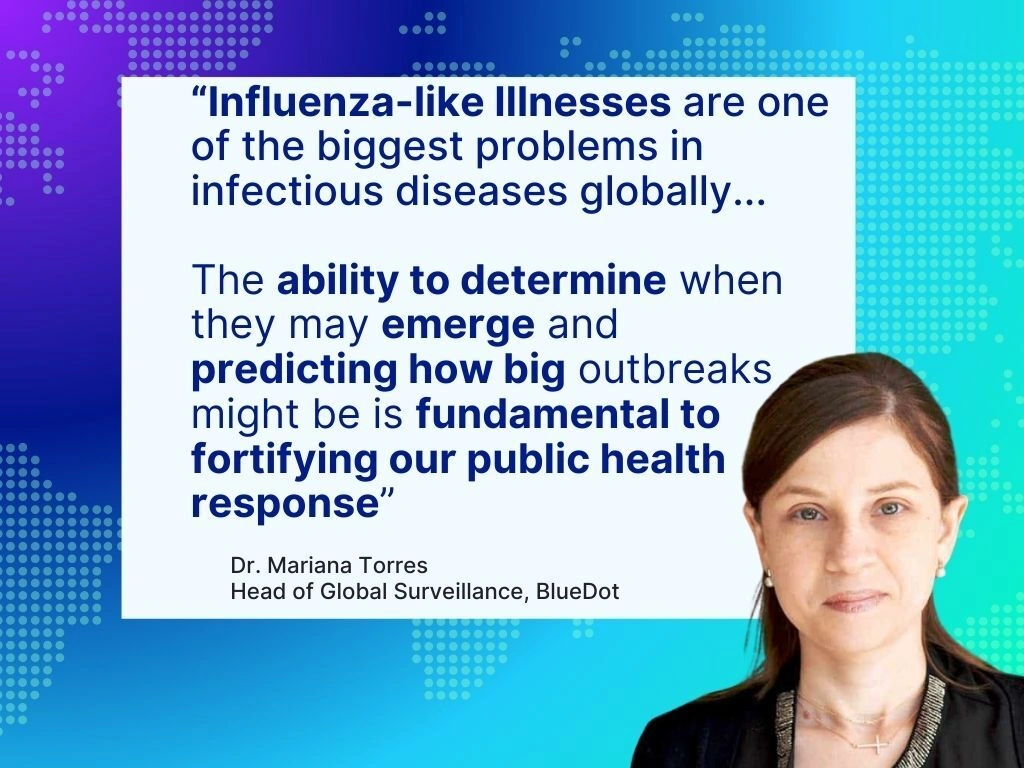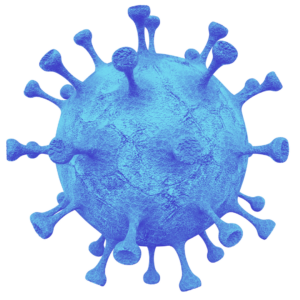Commonly believed to be nearly eradicated, the serious disease remains an ongoing threat as cases rise around the globe
October 24 was World Polio Day: an opportunity to recognize global efforts to rid the world of polio. Declared a Public Health Emergency of International Concern (PHEIC) in 2014, public health measures have made huge strides towards eradication of this infectious disease — but the battle has not yet been won. And this year, a concerning increase in polio has been seen in several countries, threatening to erode the progress made over prior decades.
As of October 23, cases of wild poliovirus have increased by more than 250% since 2023 in Afghanistan and Pakistan, where it remains endemic. Just last week, BlueDot released event alerts for a case of acute flaccid paralysis associated with vaccine-derived polio in both Vietnam and Venezuela. Both countries had not seen cases of poliomyelitis for several decades. The week before, alerts were released as environmental samples of vaccine-derived polio were detected in Spain and French Guiana. These all come on the heels of the virus’s detection in India, Nepal, and the Palestinian Territories in July and August.
“Just one case of polio is enough to pose an international public health threat, and ideally no child or individual is ever again paralyzed by any form of poliovirus,” says Dr. Mariana Torres Portillo, BlueDot’s head of surveillance. Efforts to control and eliminate the virus are crucial as failure to do so could lead to a global resurgence, with up to an estimated 200,000 cases annually within 10 years.
What we know about polio
Poliomyelitis is an infectious disease caused by the poliovirus, an enterovirus of the Picornaviridae family. There are two forms of poliovirus (1) wild poliovirus and (2) vaccine-derived polioviruses (VDPVs). Wild poliovirus is the naturally occurring poliovirus that circulated in the environment prior to the advent of vaccines. Vaccine-derived polio is a rare virus strain resulting from the oral polio vaccine (OPV). This can occur when the live, weakened poliovirus contained in the vaccine mutates in populations with low vaccine coverage. Three serotypes of naturally occurring poliovirus have been identified: Type 1, 2, and 3 (PV1, PV2, and PV3). Humans are the only known reservoir of poliovirus; thus, eradication is possible if it can be eliminated globally in humans — an achievement only claimed by smallpox.
The virus affects mostly young children and is transmitted person-to-person, primarily through the fecal-oral route. The incubation period is 7-10 days, though infected people can shed the virus for several weeks. Polio is typically asymptomatic or presents with mild flu-like symptoms, including fever, sore throat, and malaise. In more severe cases, individuals may experience muscle pain, stiffness, and overall muscle weakness. In a small proportion of people, the virus reaches the nervous system and results in irreversible paralysis. Notably, every paralytic case detected may indicate 50-1,000 more asymptomatic or mild cases going undetected. Of those who are paralyzed, up to 10% may die. No cure or effective treatment exists for those who contract the disease.
3 Top Takeaways
- Wild poliovirus is increasing in endemic countries — and re-emerging in non-endemic countries. Though nearly eradicated, wild poliovirus is still endemic in Afghanistan and Pakistan, and reported cases this year are 4-7x higher than in 2023. Non-endemic countries, including Malawi and Mozambique, reported their first human cases in 2022 after a 30-year hiatus.
- Suboptimal vaccination coverage is contributing to ongoing vaccine-derived poliovirus (VDPV) outbreaks. Historically rare, VDPV outbreaks are occurring in 41 countries largely due to decreased vaccinations and increased vaccine hesitancy. Nations undergoing conflict, or with low-quality sanitation, poor hygiene, and overcrowding are at an increased risk.
- One person with polio is enough to pose a global public health threat. A highly contagious infectious disease and an increasingly connected world mean poliovirus can easily spread internationally in under-vaccinated populations.
Polio: Past, Present, Future
Polio is believed to have existed for thousands of years given evidence of its presence in Ancient Egypt. However, it was first clinically described in 1789 and was formally recognized as a condition by 1840. A century later, polio was considered the most feared disease in the world, paralyzing or killing more than 500,000 people annually.
With the development of the first vaccine in 1955 and the adoption of a global resolution to eradicate polio in 1988, there has been a 99% reduction in polio incidence worldwide. Today, wild poliovirus is endemic in just two of 125 countries around the world. Further, both wild poliovirus type 2 and type 3 were globally eradicated in 2015 and 2019, respectively. But despite these incredible global health feats, poliovirus cases and environmental samples (which indicate human spread of the virus) have increased in recent years.
Endemic to Afghanistan and Pakistan, wild poliovirus cases have substantially increased this year. Afghanistan has reported 23 cases, and Pakistan has had 42 cases, up from only six cases in each country last year. In 2022, outbreaks of wild poliovirus were detected in non-endemic countries, which had not happened since 2016. For example, Mozambique and Malawi both saw their first cases in almost 30 years. Later determined to have been imported from Pakistan, the presence of wild poliovirus anywhere underscores the continued risk of importation and subsequent spread elsewhere.
Map of Poliomyelitis Cases in 2023
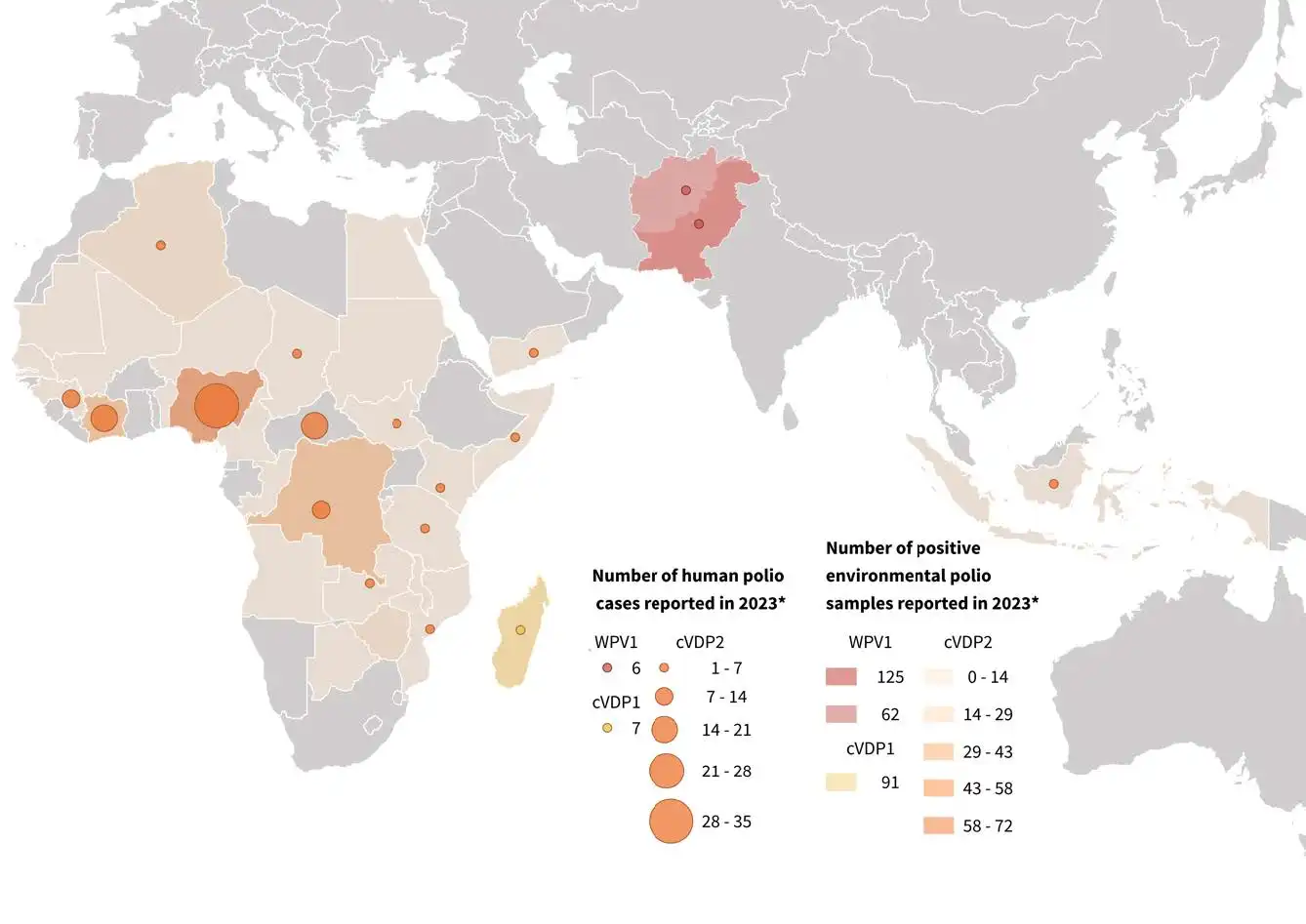
*Data for 2023 is current as of 6-Feb-2024. WPV1 = wild poliovirus type 1; cVDP1 = circulating vaccine-derived poliovirus type 1; cVDP2 = circulating vaccine-derived poliovirus type 2. Source: BlueDot Intelligence Report, March 2024
Vaccine-derived poliovirus is also increasing. There are 41 countries with outbreaks of VDPV to date. Eight new countries reported outbreaks of VDPV last year. In addition, there were 859 cases in 2022, up 23% from 2021. From French Guiana and Venezuela to India, Nepal, and Spain, VDPV has re-emerged in all corners of the world. It has even been detected in areas previously eliminated, including Canada, Israel, the UK, and the US. In a 2022 BlueDot analysis of vaccine coverage and air travel volumes, locations at highest risk of importing VDPV from non-endemic locations of interest included Spain, Italy, and the US. While these countries have a relatively high vaccination coverage, others —predominantly across the African, Asian and Latin American regions — are more vulnerable to outbreaks given lower vaccination rates. As stated by Olivia Rosenbauer, the World Health Organization (WHO) spokesperson for polio eradication, poliovirus is a plane ride away.
Map of Vaccination Coverage and Total Volume of Air Travelers from Select Non-endemic Locations that Reported Circulating VDPV2 Outbreaks in 2022
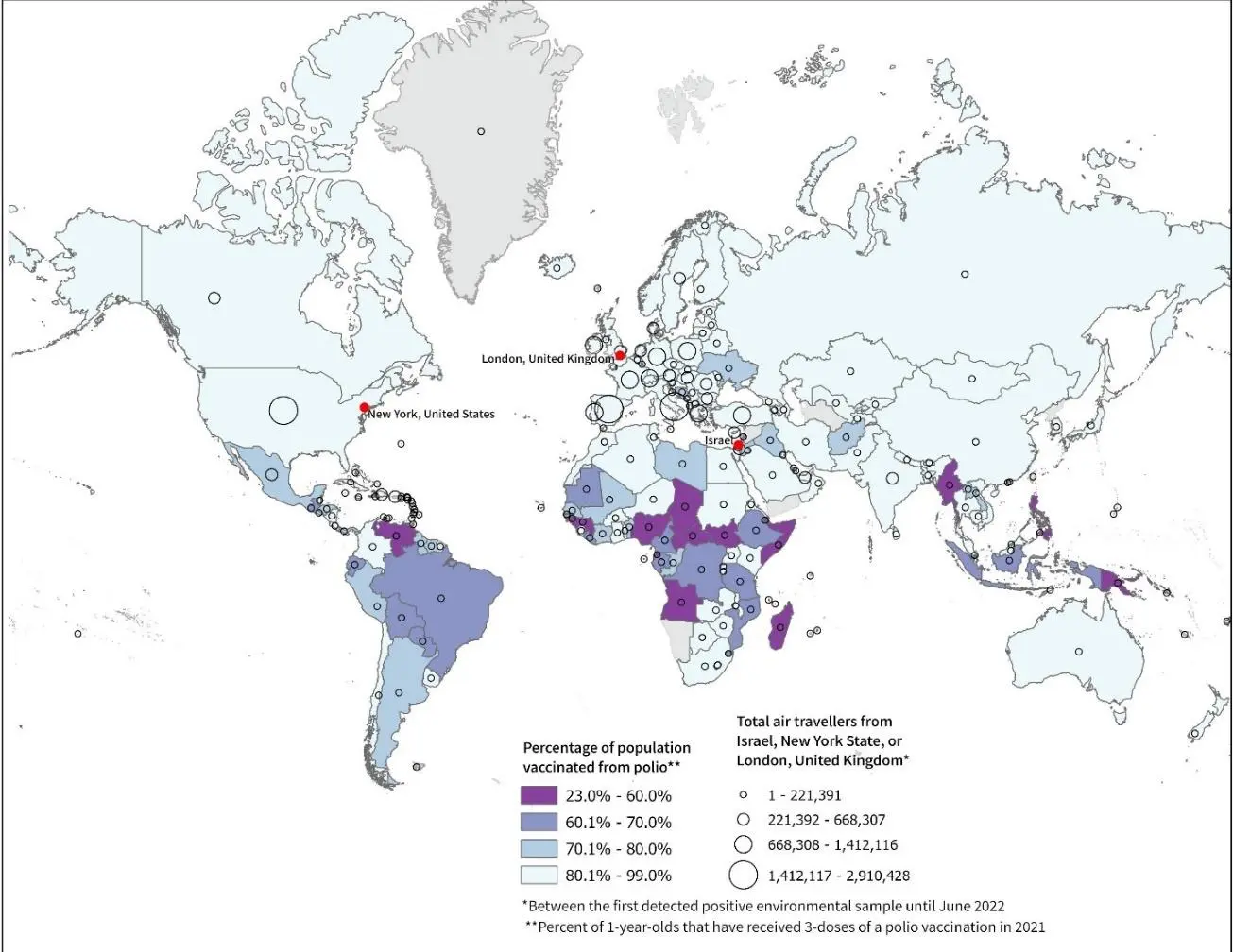
Source: BlueDot Intelligence Report, November 2022
When vaccine coverage is low, VDPV emerges. Combined with poor sanitation and hygiene, many areas around the world are at an increased risk for polio. For instance, Vietnam’s vaccination coverage in 2023 was estimated at just 59% — a number that has been steadily declining since the beginning of the SARS-CoV-2 pandemic in 2019, when the country had achieved 90.42% coverage. This upgraded Vietnam from a low-risk to a high-risk location for wild polio and/or VDPV, according to the WHO Regional Committee for the Western Pacific. Low coverage was also reported in Venezuela, where just 61% of the population were estimated immunized. The WHO recommends a 95% coverage threshold to prevent outbreaks, meaning these nations — and others — are at very high risk for broader community transmission.
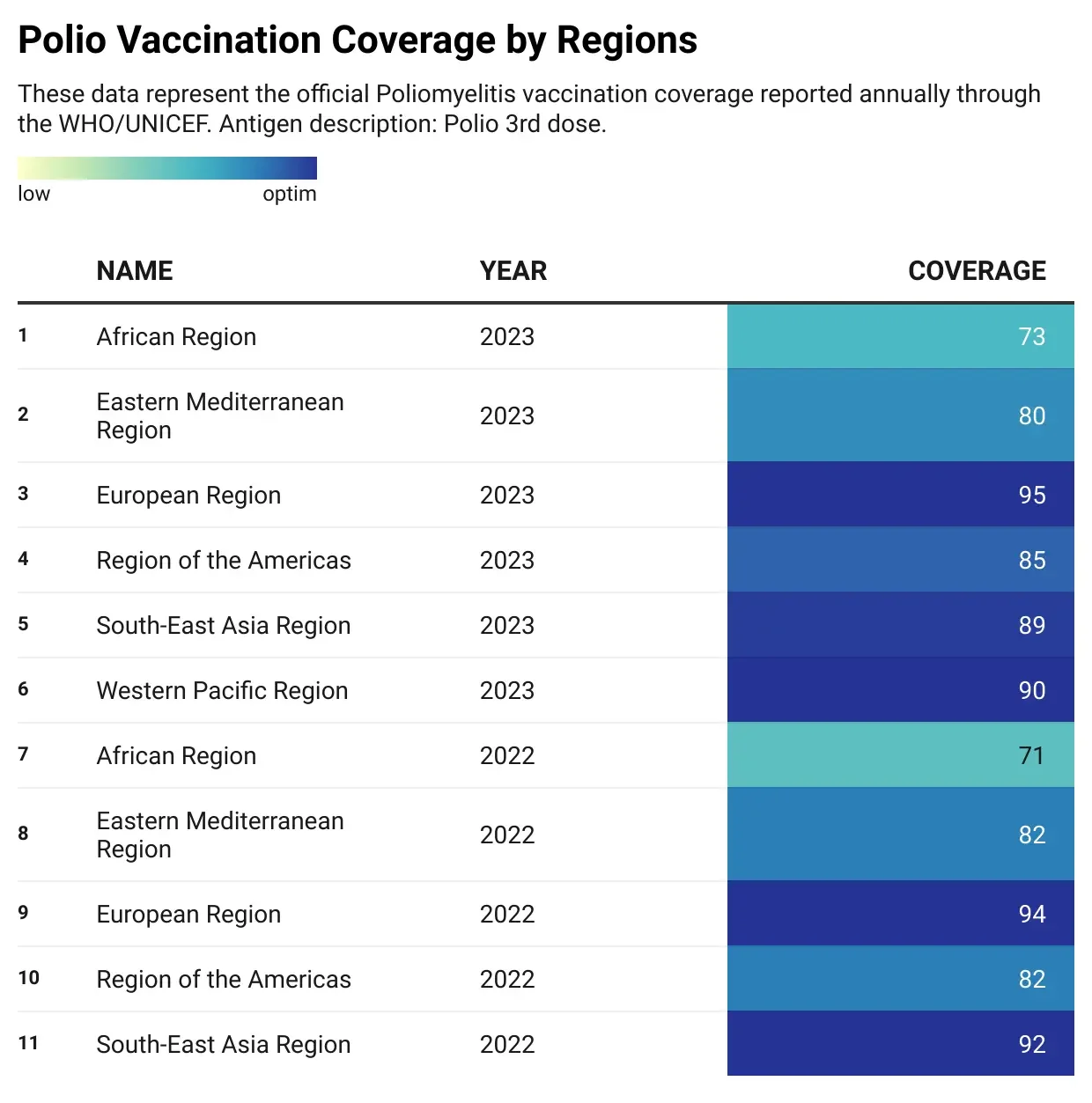
Source: WHO, created with Data-wrapper
Conflict, natural disasters, and humanitarian crises also contribute to the spread of VDPV as public health efforts are disrupted, poor access to clean water and sanitation increase, and mass displacement and overcrowding occur. After 25 years, the first human case of VDPV was reported in the Palestinian Territories in August, following detection in environmental samples weeks earlier. Last year, 85% of children affected by polio lived in vulnerable regions, emphasizing the significant challenge of implementing prompt and high-quality vaccination campaigns.
Progress has been made to increase polio vaccination coverage, but lack of timely detection, limited resources, immunization interruptions amid COVID-19, and increased vaccine hesitancy have also disrupted the rollout to high-risk populations. Adequate vaccine coverage protects against both wild and vaccine-derived polioviruses and provides the best opportunity to eradicate this serious infectious disease. Two vaccines are available to protect against paralytic polio, inactivated polio vaccine (IPV) and oral polio vaccine (OPV), and both are safe and effective. Along with continued global efforts to coordinate mass vaccination campaigns, improvements in public health infrastructure are needed if the world is to call polio a disease of the past.
On our radar
- Whooping cough around the world: Pertussis, or whooping cough, is resurging around the world as rates meet or exceed pre-pandemic levels. So far this year, rates are vastly outnumbering 2023 cases from the same period. To name just three:
- Australia: more than 32,000 cases have been reported, >39x higher
- Germany: more than 20,000 cases have been reported, >8x higher
- US: more than 18,500 cases have been reported in the US, >6x higher
- Whooping cough around the world: Pertussis, or whooping cough, is resurging around the world as rates meet or exceed pre-pandemic levels. So far this year, rates are vastly outnumbering 2023 cases from the same period. To name just three:
As mentioned in our previous Outbreak Insider on Pertussis, rising vaccine hesitancy, lower vaccine coverage, and waning immunity are key drivers of increased cases. The implications of this are already being observed, such as in France where hospitalizations rose 6-fold between March and July, and 35 deaths have been reported this year. BlueDot just published its inaugural issue of the Pertussis Pulse, a monthly report covering current global updates on pertussis cases and vaccination rates, country-specific spotlights and trends, and research highlights. To learn more, contact us here.
- H5N1 in Washington State: Eight agricultural workers tested positive for H5N1 in Franklin County, Washington, after exposure to infected poultry. This marks the state’s first human bird flu cases and brings the nation’s number of states with human H5N1 cases up to six.
To stay in the know about polio and other infectious disease outbreaks around the globe, sign up here to receive every edition of BlueDot Outbreak Insider.


